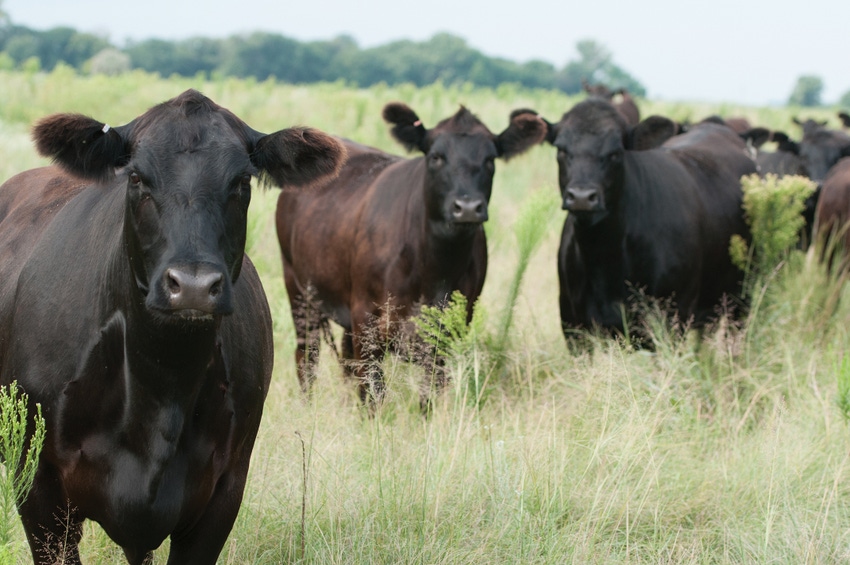Genomics 101: How to implement genomics in your cowherd
Understanding the science behind genomics is less important than knowing how clients can use the technology most effectively.
November 9, 2015

Where veterinarians can really be helpful is educating their clientele about how to use genomics in their selection decisions and in their genetic risk mitigation strategies,” says Matt Spangler, a beef genetics specialist at the University of Nebraska.
“The tools work. That’s no longer a question. The pertinent questions revolve around appropriate use and implementation,” says Bob Weaber, extension cow-calf specialist at Kansas State University. “Veterinarians can help clients understand the context in which information should be applied. Maybe most important is not misusing the tools.”
However, both believe the first order of business for any discussion with producers regarding genetics and genomics is defining the specific goals of the operation. Without them, there is no way to know where and how genetics and genomics can help.
“Having a disciplined goal is the difference between operations that prosper economically over time, and those that don’t,” Spangler says. “Veterinarians can play a role in sitting down with their clientele and helping establish production goals and helping identify areas of improvement if those goals are not achieved.”
Cattle genomics in brief
“Genomic information gives an accurate picture of what alleles an offspring inherited from its parents in the form of single nucleotide polymorphisms (SNPs—pronounced “snips”),” Weaber explains.
Think of an allele as one of two or more versions of a gene. Cattle inherit two alleles of each gene, one allele from each parent.

Alison Van Eenennaam, University of California at Davis
SNPs are genetic markers, “where alleles differ from each other by the sequence of only a single nucleotide base pair,” explains Alison Van Eenennaam, an extension beef cattle specialist at the University of California at Davis. She is an internationally recognized expert in beef cattle genomics. In an insightful fact sheet you can find at eBeef.org, she continues, “SNP genetic tests focus on detecting precise single nucleotide base pair differences among three billion nucleotide base pairs that make up the bovine genome.”
DNA is comprised of pairs of nucleotides.
“A gene is a stretch of DNA that specifies all of the amino acids that make up a single protein,” Van Eenennaam explains. “Proteins are the building blocks of life. There are thousands of proteins in the body encoded by thousands of genes. The interaction and structure of proteins determines the visible characteristics or phenotype of an organism, while the genotype refers to the genetic makeup.”
Specifically, Van Eenennaam explains that genotyping is the process of using laboratory methods to determine which DNA marker alleles an individual animal carries.

Bob Weaber, extension cow-calf specialist at Kansas State University
When you hear that an animal has been genotyped for 50K, that means the genomic snapshot includes DNA markers at 50,000 locations on an animal’s chromosome. In other words, at 50,000 locations, the technology tracks whether an animal inherited the most favorable or unfavorable genetics from his parents.
“Some are moving towards reduced-density panels (such as 20K) with the aid of imputation,” Weaber says. He explains imputation essentially utilizes population information to fill in the blanks of missing genotypes, “as DNA is inherited in large blocks (chromosomes) with occasional recombination events that join segments of the chromosomes of either maternal or paternal grandparents during the formation of sperm or ova.”
“The research community is commonly using 50K, 80K or 770K genomic tests for discovery of novel traits, such as feed efficiency and disease susceptibility,” Weaber explains.
This genotypic information can be translated into molecular breeding values (MBVs). MBVs can then be incorporated into the calculation of expected progeny differences (EPDs) if the breed has what’s known as a training population. In effect, that means there must be a large enough population, interrelated enough, with enough phenotypic and genotypic data to develop the necessary prediction equations. That’s why some breeds have struggled to adapt the technology within existing genetic cattle evaluation.
This is also why genomic tools, necessarily, tend to be breed-specific.
“It is important to realize the difference between a breeding value (molecular-based or phenotype-based) and an EPD,” Spangler explains. “A breeding value is equal to twice an EPD. A breeding value is the genetic potential of an animal. An EPD is the genetic potential of an animal as a parent, given that only a random half of an animal’s alleles will be passed to the next generation.”
Select bulls with more genetic accuracy
“When genomic information is included in genetic evaluation, particularly for young sires, it has the potential to increase the accuracy of the EPD,” Spangler explains.
“Genomics change the precision with which we can select yearling bulls,” Weaber says.
They’re talking about the genomic enhanced (GE) EPDs you’ve heard about and already likely have helped clients use.
Depending on the trait, the accuracy of GE EPDs for yearling bulls are similar to bulls for which performance from up to 20 or so calves has already been documented and considered within the genetic prediction.
“Genomics can account for one-third to two-thirds of the genetic variation for some traits in GE EPDs. It can point us in the right direction earlier in an animal’s life,” Weaber explains. “It’s a big time saver. The additional information is really valuable when we think about traits of consequence like calving ease, traits that are costly to measure, and those that take a long time to describe phenotypically, like fertility and carcass traits.”
Increased accuracy offers bull buyers less risk.
“It’s important to keep in mind that the genetic progress you’re going to make is through the sire,” Spangler says.
“The commercial producers’ best use of genomics at this point is to make sure EPDs of the bulls they consider are genomically enhanced,” Weaber says.
“A bull’s EPDs can still change, but they won’t change as much if the genomic information is included,” Spangler says. “The danger is that with increased accuracy we should be able to make faster genetic change, which is good if you know where you’re going.”
Another way GE EPDs save time comes with the fact more information is included in a single measure (the EPD) that producers have used for decades.
In terms of practical application, Spangler uses the example of seeing the first bull on your list bringing a price well beyond your budget. Maybe the fifth bull on your list is bringing well less than your budget. If genetic evaluation and your homework say the bulls offer similar genetic value to your herd, that’s a buying opportunity.

BEEF Seedstock 100
Looking for a new seedstock provider? Use our BEEF Seedstock 100 listing to find the largest bull sellers in the U.S. Browse the Seedstock 100 list here.
Unfortunately, Spangler explains, “A lot of producers divorce genomics from the EPD, and they shouldn’t.”
Some producers want to consider both the MBV of a bull, as well as the bull’s EPD, which accounts for the MBV. Some want to consider each as separate measures.
“Genomic tests only account for a portion of the genetic variation in the population, while EPDs at high accuracy account for most of the genetic variation in the population, so it’s a part-whole relationship,” Weaber explains. “Considering the two pieces of information independently doesn’t make much sense.”
“The fundamentals don’t change,” Spangler says. “Develop a good crossbreeding system. Know what traits are economically important to you, then select bulls based on EPDs and selection indexes, some of which will be augmented with genomic information.”
Mitigate genetic risk
Parentage identification through DNA marker technology is another way commercial producers can use genomics to reduce or manage genetic risk.
For one thing, it allows commercial producers to identify bulls that don’t fit their needs.
“Suppose you run bulls in multi-sire pastures and encounter more calving problems than your selection of heifer bulls suggested you would,” Spangler says. “You can test the calves (and bulls) and assign sires to them. If you find one of the bulls doesn’t fit your heifer bull battery, you can move him to pastures with mature cows or get rid of him. As a veterinarian, that’s a strategy you can use to find the bulls causing calving problems in client herds.”
The opposite is also true. The same strategy can be used to identify sires proving themselves to be superior.

Matt Spangler, a beef genetics specialist at the University of Nebraska
On both counts, and carried to the far end of the spectrum, producers who parent-identify all of their calves over the long haul essentially build pedigrees for the calves. These inferred pedigrees can be used to calculate in-herd EPDs, as some commercial producers are doing.
Spangler cautions, however, effective use of this tactic requires phenotypic data from a substantial number of calves each year, either produced by the operation or as part of some sort of cooperative that shares such information.
“In the past few years, as bull prices have increased, a lot of commercial producers have called me about raising their own bulls. That’s not as easy as some make it out to be,” Spangler says.
Likewise, Weaber says, “I think inferred pedigrees and in-herd EPDs are useful, but we have to think through the ROI [return on investment].”
Easier to justify, in Weaber’s opinion, is utilizing parentage testing to leverage the cost of commercial AI programs.
“Use paternity testing to make sure we’re keeping the AI heifers,” Weaber says. “Parentage testing is relatively inexpensive and it helps leverage our AI costs. It adds precision to our selection decision.”
Manage genetic recessive disorders
Although plenty of heartburn still accompanies discovery of a simple recessive genetic disorder, credit DNA for the ability to manage around the defect genetically, rather than simply sacrifice entire sire lines or cow families.
“These tests allow a veterinarian to sit down with clientele to develop a breeding plan that mitigates risk,” Spangler explains.
On one hand, tests can be used to avoid disorders that represent risk to the herd. On the other hand, in some situations, some producers can take advantage of bulls discounted as carriers but pose no risk to the cow herd of consideration.
For commercial producers, Spangler suggests, “Keep track of the bulls you’re using. File away the papers where you can find them so that if a new genetic defect arises, you can see if your herd is at risk.”
For seedstock producers, Spangler believes banking a couple of straws of semen from all bulls used should be standard operating procedure.
“Alternatively, producers should consider storing a DNA sample from hair or blood on each bull turned out,” Weaber says. “Having a standard procedure to archive DNA is important for downstream genotyping decisions. If you sold the bull before you collected a DNA sample, then you are precluded from using the available genomics tools.”
As seen in recent years, odds favor more genetic recessive disorders coming to light. “As the list grows, that’s where the consulting veterinarian can help clients determine which ones represent the greatest risk to the client’s herd, and help them select bulls that mitigate the risk,” Spangler says.
Of course, for genetic recessives as well as many other production considerations, Spangler notes that crossbreeding is one of the most effective risk mitigation strategies.
“If there’s an unidentified genetic defect, veterinarians need to know what to do. Take a picture and a tissue sample of the calf and contact the breeder. Perhaps call the breed association as well,” Spangler says. “Then help clients with sire selection, using EPDs. Encourage them to think about the value of increased accuracy.”
Commercial DNA panels for trait areas
As mentioned earlier, when a robust enough reference population exists, genomic information can be translated into MBVs. One way or the other, this is the basis of commercially available genomic tests that seek to describe the genetic merit of bulls, steers and heifers for various traits or trait areas.
Some seedstock and commercial producers are using these tests to great advantage in particular systems. They understand the capabilities and limitations of specific tests and can justify their cost within their unique selection and marketing strategies.
“Applied in the right context, in a skillful way, they can be very useful,” Weaber says.
Some, out of sheer hope or a lack of understanding, try to stretch these tests to fit uses, breeds and breed combinations for which they were never intended.
Lots of others, if they consider genomic tools at all, are sitting on the top rail, watching the dusty chase of the first adopters, waiting to see what’s left in the wake.
So, veterinarians helping clients determine the value of specific genomic tests should start first with assessing whether or not the test in question is designed for the intended purpose.
“With what we know about genomics and beef cattle production systems, we do a poor job of predicting the genetic value of unregistered crossbred cattle. We also do a poor job of predicting the genetic value of cattle within a breed that are unrelated to those used to develop the genomic test,” Spangler explains. “Some tests are clearly designed and marketed for use within a single breed. If producers deviate from that in their use, I wouldn’t expect the test to work.”
Next, when clients are trying to choose between tests that seem similar, keep in mind the only value to genomic tests (including GE EPDs), is how much genetic variation is explained by knowing about the specific markers.
“It’s important for veterinarians to recognize the traits in the test, and if possible, how much genetic variation is explained for those traits by the test,” Weaber says. “Is being able to select for improvement in your herd valuable? If it is, can you capture the value practically?”
If you can describe one-third to two-thirds of the genetic variation for carcass traits and drive genetic improvement by testing heifers, for example, that may represent tangible value to a seedstock producer building bulls, or to a commercial producer who retains ownership in his calves through the feedlot year in and year out. They have a means to capture the value of making improvement in those areas.
Even when such opportunity exists, Weaber says, “Recognize that there are still a number of traits antagonistic to production.”
For instance, selecting for increased growth may add more pounds to weaned calves and yearlings, but it also contributes to increased mature cow size.
Likewise, even if the test is applicable, Spangler cautions about making sure it’s practical in a particular situation. He uses the example of testing commercial replacement heifer candidates.
“Once you eliminate those born too late in the season, those with subpar performance or a poor attitude, there may not be many more culling decisions left to make,” Spangler says. “I have a hard time rationalizing spending $25 to $45 per head for testing the remaining heifers to find the small fraction that the test may suggest I should cull. Just because an animal ranks high for a given genomic test, it in no way predicts with absolute certainty that she will breed as a heifer.”
Spangler emphasizes, “Remember, the progress commercial producers make toward their production goals, from a genetics perspective, will be driven by the sire selection decisions they make.”
Weaber also points to other non-genomic variables that influence the ability of a heifer to breed, calve on time and breed back, like when she’s born in the calving season, body condition at breeding, etc.
Weaber also cautions folks to consider the cost of testing in terms of the number of heifers retained, much like figuring the cost of death loss for a pen of steers across those that are marketed. In this case, if it costs you $30 per head to test four heifers and you end up keeping two of them, Weaber points out it cost you $60 per retained heifer.

Breathtaking photos of winter on the ranch
The first snow hit parts of the Midwest this week. Mentally prepare for the winter wonderland with these stunning photos. See photos here.
“You still have to use the same selection sensibilities. Balance and emphasize traits as you would with EPDs,” Weaber says. “It’s not a silver bullet. It’s another piece of information that must be applied within multi-trait selection. Pragmatism must still be applied to build effective selection strategy.”
Figure value starting with goals
This is another way of saying, keep in mind cost relative to return.
“Is it worth the increased cost? That’s the question I believe producers must ask themselves when considering any new technology,” Spangler says. “Does it offer the potential to increase economic returns?”
Beyond the use of genomics within breed genetic evaluation, to match sires to calves or to identify carriers of genetic recessive disorders, Weaber emphasizes the returns from genomic testing must be realized through selection and marketing.
If genomic information is intended for use in marketing, then cattle must be marketed in such a way that the information matters. It’s similar to someone who incurs the cost of weaning and preconditioning calves, but then doesn’t share the information with prospective buyers, or markets cattle in such a way that there’s no reason for buyers to pay more.
If genomic information is intended for selection, it must be used in selection. Huh?
“In making selections, time and again, we see seedstock producers genotype only a portion of their sale offering,” Weaber says. Before testing, they’ve already decided which bulls will be sold to breed cows. Genomic information wasn’t used in their selection. The same goes for females.
“If we’ve already made our decision, genomics won’t provide us any information useful for selection, making it pretty difficult to justify the investment,” Weaber emphasizes. “The appropriate time to use this information for selection is during the selection process.”
Incidentally, when it comes to utilizing genomics in benchmarking, Spangler says, “The problem with using genomic data to benchmark a commercial herd is that you’re assuming the test is predictive and that it’s equally predictive across every animal you test.
“To benchmark the commercial herd, I’d use phenotypic data rather than genomics, things like calving rate, pregnancy rate and adjusted weaning weight. Those things tell you if you’re getting closer to your goals,” Spangler says. “Part of benchmarking is knowing if you’re getting closer to your production and economic goals.”
“Define goals. If decisions aren’t made in order to progress toward defined goals of value to that operation, then it’s a waste of resources,” Weaber says. “What economically valuable traits are important to that production system? How do genomic tools help achieve those goals?”
Genomic resources
Even if you have a passion for beef cattle genetics, keeping up with the fast paced evolution of genomics can be tough.
“Realize that you don’t always have to know the answer, but you need to know where you can find it,” says Matt Spangler, a beef genetics specialist at the University of Nebraska. “Realize that there are people who specialize in beef cattle genetics and reach out to them.”
Extension specialists like Spangler and those mentioned in “Genomics 101” are among that group. They and their peers are also the intellectual foundation to the eBEEF website, eBeef.org. There you’ll find an array of fact sheets and articles that cover the basics of genomics and their practical application.
eBEEF is easy to navigate because of the narrow focus. It’s a branch of the eXtension.org website developed and maintained by extension specialists from land grant universities.
Spangler also mentions the website for the National Beef Cattle Evaluation Consortium (NBCEC.org). There’s a world of information, including archives of the Brown Bagger Series (look under the “For Professionals” tab) which provides updates about genomic tools and uses.
Other web-based resources include:
About the Author(s)
You May Also Like





